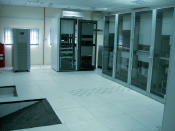Information
In the course of performing their various functions, government officials deal with large volumes of information on a daily basis. They also need ready access to data and knowledge bases. A secure communications infrastructure based around a server room and/or data centre providing uninterrupted service to critical data processing and information management operations is essential.
The primary goals of the IT infrastructure component are twofold:
Implement the best possible IT infrastructure standards that can be applied by any government agency for current and future IT requirements;
Within the boundaries set by a project and its budget, deploy the necessary equipment and expertise in conjunction with the government agency's ICT team, to support the necessary infrastructure requirements.
goIDM follows the four core principles that form the foundation of ICT infrastructure and data centre design philosophy - simplicity, flexibility, scalability and modularity. This approach leads to the single most important requirement, namely after-project sustainability.
- The main features of goIDM are:
- 24 x 7 x 365 availability
- Secure Internet access and high-performance communications infrastructure
- Application hosting
- Content distribution
- File storage and backup
- Databases and applications management
- Fail-safe reliability and continuous monitoring
- Redundancy and path diversity for power, cabling, Internet access, etc.
- Racks, cabinets and support infrastructure
- Adequate cooling of electronic devices via access flooring, specialized racks and other ducting methods
- Physical and network-access security and surveillance
- Zoned environmental control (temperature, humidity, etc.)
- Fire suppression and early warning smoke detection systems, etc.
- For informed and rational decisions regarding ICT infrastructure requirements;
- Provision of a practical model for the utilization of well designed and tested infrastructure to allow for efficient and, where necessary, decentralised electronic communications; and
- For capacity to manage all types of information, ranging from basic human resources data to highly confidential information, and to monitor and manage performance and quality control.



